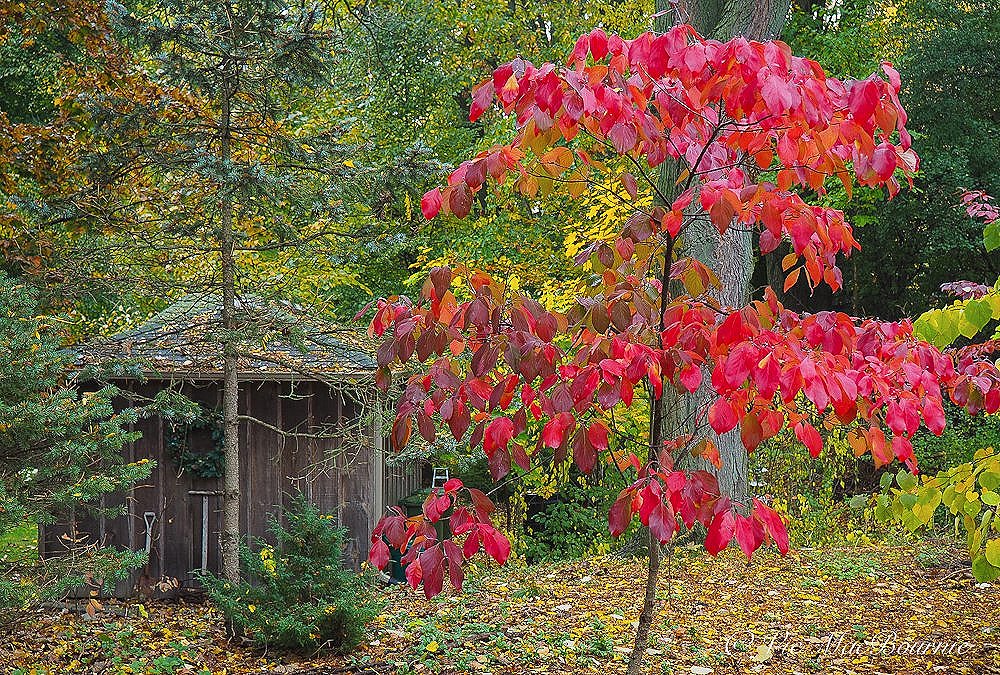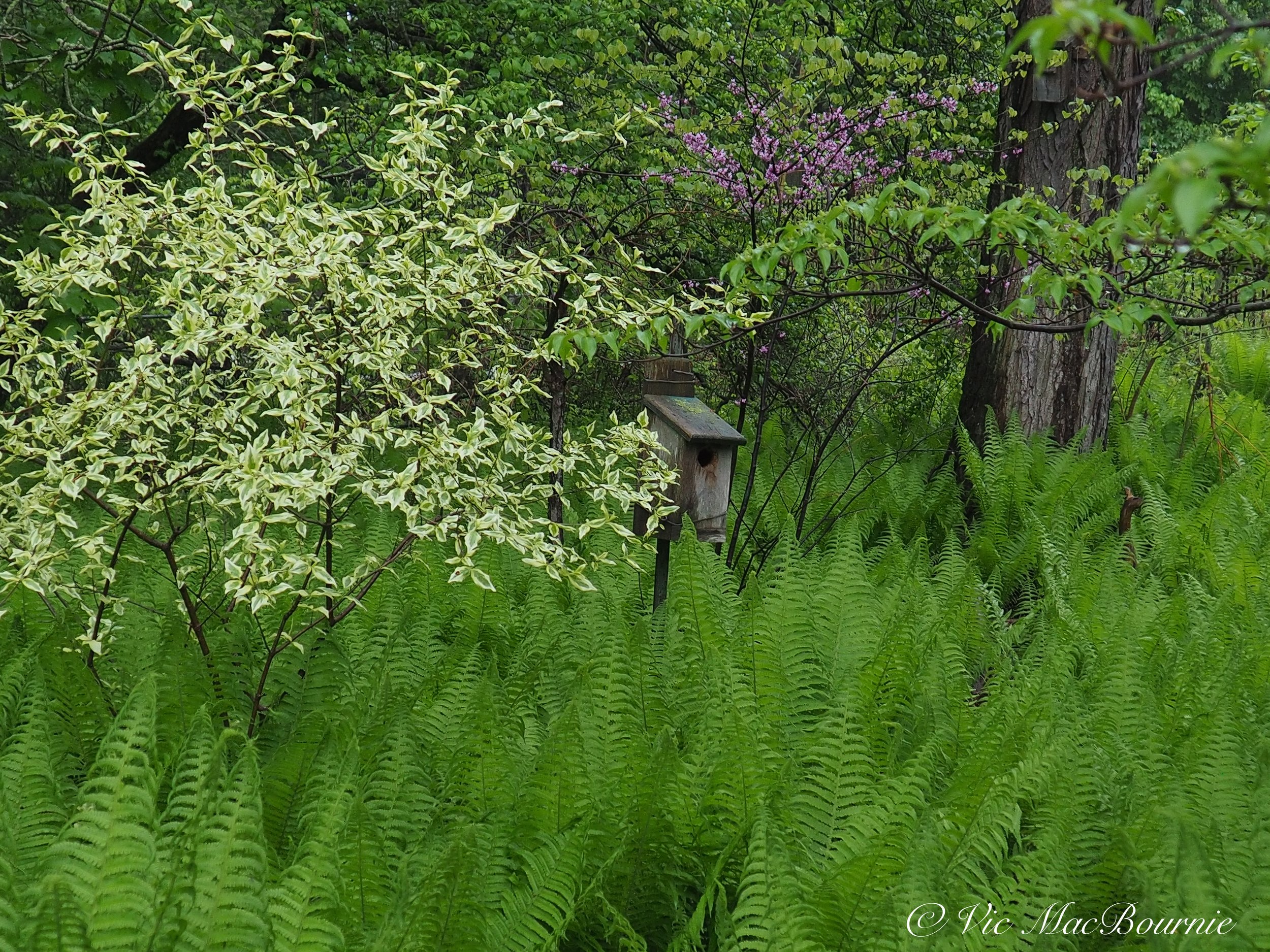Dogwood tree leaves shine spring, summer and fall
What makes Dogwood foliage so interesting?
Anyone who has followed my posts on Ferns & Feathers knows my deep appreciation and love for Dogwoods in the garden. These plants, shrubs and small understory trees are both a versatile and highly welcome addition to any garden, but fit in especially well in a woodland style garden.
Obviously, the spectacular spring and early summer flowers of the Flowering Dogwood (Cornus Florida), Cornus Kousa (Cornus Chinensis), and even the diminutive Bunchberry or (Cornus Canadensis) are the primary reasons to plant these Dogwoods in your garden. It can be argued, however, that the foliage of both the Cornus Florida and Cornus Kousa, as well as those of the Pagoda dogwoods and Bunchberry are impressive in their own right and add to the garden’s aesthetic.
In our garden, I’ll add the variegated leaves of the Cornus Mas (see image below) as another stalwart in woodland garden.
Even Paul Cappiello, in his comprehensive book, Dogwoods has praise for the foliage of the Dogwood genus.
“Most dogwood species sport medium green summer foliage, and, with the exception of the many variegated forms, few are standouts in this regard,” Cappiello writes.
“But it is in autumn that the leaves can really shine. Reds, yellows, oranges, and burgundy shades can develop alone or in concert to form spectacular autumnal dress. To be truthful, on the full-family scale, there are as many poor fall-coloring species as there are those that would inspire poets. Dogwoods seem to have benefited from wonderful public relations in this realm.”
In fact, Dogwood foliage possess several positive traits that make them highly desirable in gardens and landscapes.
One of the key advantages of dogwood leaves is their attractive shape and texture. The leaves are typically oval or elliptical, simple, with smooth edges and a glossy surface. The lower leaf surface is often covered with copious amounts of single-celled T-shaped trichomes (hair-like structures) that are loaded with calcium carbonate.
How to identify dogwood leaves
“All dogwood leaves show a rather unique arcuate veination, the major veins arranged much like lines of longitude on the globe. In addition, the major leaf veins contain a latex-like substance that form strands when pulled apart,” explains Cappiello, in his book.
You might even describe the leaves of dogwood as giving a refined and elegant appearance, adding a touch of sophistication to your garden throughout the season.
“But it is in autumn that the leaves can really shine. Reds, yellows, oranges, and burgundy shades can develop alone or in concert to form spectacular autumnal dress. To be truthful, on the full-family scale, there are as many poor fall-coloring species as there are those that would inspire poets. Dogwoods seem to have benefited from wonderful public relations in this realm.”
Their emergence in spring marks the beginning of a stunning display of beauty that lasts throughout the year. From the moment they unfurl, dogwood leaves captivate with their vibrant green hues and delicate, unique shapes. Whether it’s the iconic native flowering dogwood or the lesser-known native Pagoda dogwood, their leaves never fail to make a statement.
In our garden, the emergence of the bright green dogwood leaves is almost as special as the first sign of their flowers in spring. The emerald greens and the deep veining of the leaves, contribute to dogwoods’ distinctive look.
For more of my posts on Dogwoods, be sure to check out these articles:
Flowering Dogwood: Queen of the Woodland garden
Cornus Kousa: Impressive non-native for the woodland garden
Bunchberry: The ideal native ground cover
Pagoda Dogwood: Small native tree ideal for any garden
Cornus Mas: An elegant addition to the Woodland Garden
Dogwood leaves are good indicator of problems
The leaves of the Dogwood will often inform us of disease or other problems our Dogwoods are facing. Watch for black spots or curling of the leaves as indicators of possible problems. Curling leaves may be nothing more than the tree protecting itself from the harsh sun, but they could be an indicator of more serious problem. More information on potential problems later in this article.
Dogwoods are impressive in their fall colors
Another positive trait of dogwood leaves is their versatility in terms of color.
While some varieties are known for their vibrant fall foliage, others exhibit stunning colors throughout the year. From deep greens in spring and summer to rich reds, oranges, and purples in autumn, dogwood leaves provide a dynamic and ever-changing display of color in our gardens.
In addition to their visual appeal, dogwood leaves offer practical benefits as well. They provide shade and shelter for birds and other wildlife, making them an important part of the ecosystem.
The leaves of the Dogwood also contribute to soil health by decomposing and enriching the soil with organic matter.
Furthermore, dogwood leaves are relatively low-maintenance. They are resistant to many common pests and diseases, making them a more or less hassle-free choice for gardeners.
The trees’ and shrubs’ moderate size and density also reduces their potential negative effects on turf, if that is a concern.
As the seasons progress, dogwood leaves continue to enchant. In the summer, their lush foliage provides a refreshing canopy of shade, creating a cool and inviting area to plant woodland-loving plants. Try acid-loving plants like ferns and spring ephemerals such as trilliums and native geraniums.
This image shows the umbrels of the Pagoda Dogwood, but take note of the elegance of the trees deep green leaves that are heavily veined and create the perfect backdrop to show off the creamy flowers.
It is in the fall that dogwood leaves truly shine.
As the temperatures drop, these leaves transform into a kaleidoscope of colors, ranging from fiery reds and oranges to rich purples and yellows. Their vibrant hues create a breathtaking spectacle, turning our landscapes into a picturesque scenes.
Moreover, dogwood leaves have a unique ability to retain their color well into the late fall, ensuring that their beauty lasts longer than many other tree species. This extended display of color adds an extra touch of magic to the autumn season.
This image shows the leaves of a Flowering Dogwood in early fall color with next year’s flower buds.
In conclusion, the special and attractive qualities of dogwood leaves lie in their year-round beauty, from their emergence in spring to their stunning fall colors. Their vibrant hues, intricate veining, and long-lasting color make them a standout feature in any landscape.
So, whether you’re admiring the flowering dogwood or the Pagoda dogwood, take a moment to appreciate the exceptional beauty of their leaves.
What diseases should we look for in dogwood leaves?
Anthracnose is indeed a common disease that affects the leaves of Flowering Dogwood. However, there are other diseases that can also show up in dogwood leaves.
It’s important to be able to recognize the early signs of disease in order to take appropriate action and prevent further damage to the tree.
One of the early signs of disease in dogwood leaves is the presence of spots or lesions. These spots can vary in size, shape, and color depending on the specific disease.
For example, anthracnose may cause small, dark brown or black spots with a purple halo, while powdery mildew may result in white or grayish patches on the leaves.
Another sign to look out for is leaf discoloration. Diseased dogwood leaves may exhibit yellowing, browning, or even reddening, depending on the disease. This discoloration may be localized or spread throughout the entire leaf.
In addition, wilting or drooping leaves can indicate the presence of disease. Diseased dogwood leaves may lose their turgidity and appear limp or wilted, even if the soil moisture is adequate.
It’s also important to pay attention to leaf deformities. Some diseases can cause the leaves to become distorted, curled, or misshapen. These deformities can range from minor abnormalities to severe malformations.
If you notice any of these early signs of disease in dogwood leaves, it’s crucial to take action promptly. Consult with a professional arborist or horticulturist to accurately diagnose the disease and determine the appropriate treatment. Early intervention can help prevent the spread of the disease and protect the overall health of the dogwood tree.
For a complete breakdown of diseases that face Dogwoods, check out this page from the University of Maryland.
What are the best dogwood leaves for fall color?
Dogwood trees are known for their stunning fall foliage, and some varieties have leaves that are particularly exceptional in terms of color. When it comes to the best dogwood leaves for fall color, two varieties stand out: the Kousa dogwood (Cornus kousa) and the Red Osier dogwood (Cornus sericea).
The Kousa dogwood is native to East Asia and is highly regarded for its vibrant fall foliage. Its leaves turn a beautiful deep red or purple, creating a striking contrast against the tree’s dark bark. The Kousa dogwood’s leaves also tend to stay on the tree longer than other varieties, prolonging the enjoyment of their autumn hues.
On the other hand, the Red Osier dogwood, also known as the Red Twig dogwood, is native to North America. While its fall foliage may not be as showy as that of the Kousa dogwood, it’s bright red stems offer a stunning display of color throughout the winter months. The leaves of the Red Osier dogwood turn shades of red, orange, and purple, adding warmth and vibrancy to the autumn landscape.
Both the Kousa dogwood and the Red Osier dogwood are excellent choices for homeowners looking to enhance their fall gardens with colorful foliage. Whether you prefer the intense reds and purples of the Kousa dogwood or the warm tones of the Red Osier dogwood, these varieties are sure to bring beauty and visual interest to your outdoor space during the fall season.
Do dogwood leaves make good tea?
Do dogwood leaves make good tea? This is a question that many people have when they see the beautiful leaves of the dogwood tree. While dogwood leaves are not commonly used for tea, they do have some potential benefits.
One of the main benefits of dogwood leaves is their high antioxidant content. Antioxidants help to protect the body against damage from free radicals, which can contribute to aging and disease. By consuming dogwood leaf tea, you may be able to boost your antioxidant intake and support overall health.
In addition to antioxidants, dogwood leaves also contain certain compounds that have anti-inflammatory properties. These compounds can help to reduce inflammation in the body and alleviate symptoms of conditions such as arthritis and allergies.
To make dogwood leaf tea, simply steep a handful of fresh or dried leaves in hot water for about 10 minutes. You can add honey or lemon for flavor if desired. However, it's important to note that dogwood leaves may have a slightly bitter taste, so you may want to adjust the amount of leaves or steeping time to suit your preference.
While dogwood leaf tea may not be as well-known as other herbal teas, it can be a unique and potentially beneficial addition to your tea collection. Just remember to consult with a healthcare professional before incorporating any new herbal remedies into your routine, especially if you have any underlying health conditions or are taking medications.
Author Profile: Vic MacBournie is a former journalist and author/owner of Ferns & Feathers. He writes about his woodland wildlife garden that he has created over the past 25 years and shares his photography with readers.









